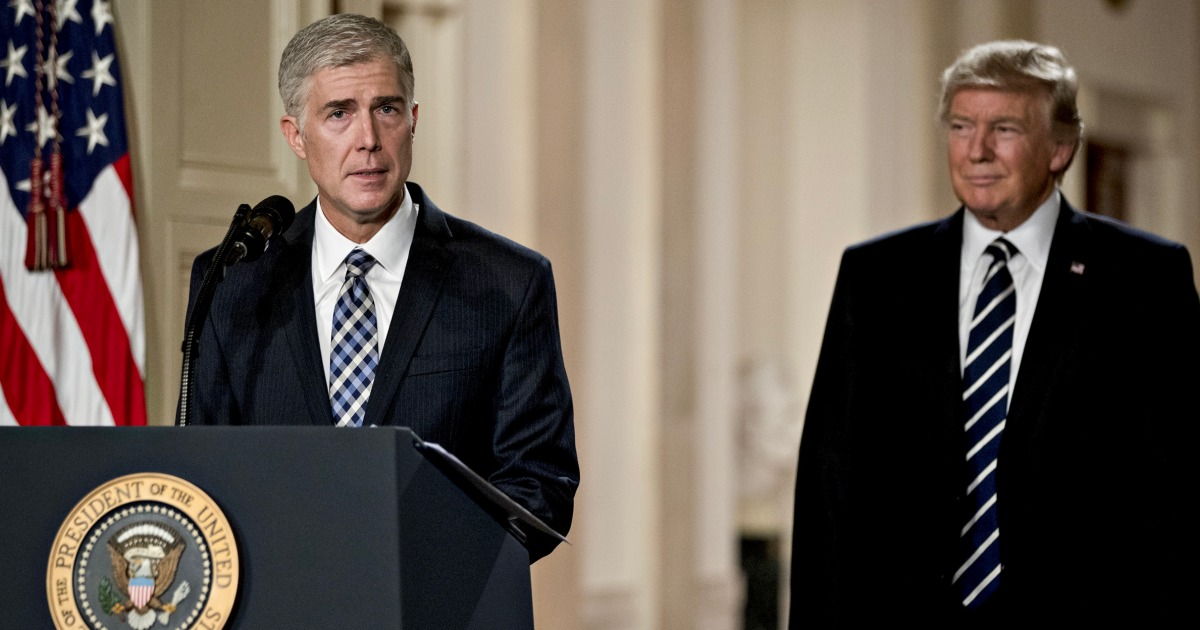
WASHINGTON — Former President Donald Trump’s top lawyer put it bluntly when speaking at a conservative conference five years ago: The goal was to name judges who would help further the administration’s deregulation agenda.
“There is a coherent plan here where actually the judicial selection and the deregulatory effort are really the flip side of the same coin,” White House counsel Don McGahn said onstage at the Conservative Political Action Conference in 2018.
That plan is bearing fruit. The Supreme Court’s new nine-month term starts Monday, with three major cases shaped by Trump-appointed judges that could hobble federal agencies already on the docket.
The process started when, among other things, prospective Trump nominees were probed about their views on federal agency authority as their records were scrutinized for expertise on the issue, something previous administrations had not done, McGahn said. He cited Justice Neil Gorsuch, then recently appointed to the Supreme Court, as an example of what the White House was looking for.
Long after Trump has left office, his judges and justices are making their mark just as McGahn predicted, serving as participants, liberal critics say, in what Trump adviser Steve Bannon called the “deconstruction of the administrative state.”
In all three cases now before the Supreme Court, Trump-appointed judges were involved in lower court rulings that teed up the legal issues for Supreme Court review. The court’s conservative majority has repeatedly shown its willingness to limit bureaucratic authority.
Brianne Gorod of the left-leaning Constitutional Accountability Center said there had been a “long-standing multifaceted conservative attack on the administrative state” that includes two elements.
The first is to find suitable plaintiffs to bring the challenges.
The second is to ensure there are “judges on the bench who will be receptive to those arguments,” she said.
McGahn did not respond to messages seeking comment on how Trump’s approach has fared.
Trump made judicial appointments a priority, with the acquiescence of the Republican-led Senate. He appointed 54 appeals court judges and 174 district court judges, as well as three Supreme Court justices. President Joe Biden, aided by a now Democratic-controlled Senate, has followed Trump’s lead in trying to fill judicial vacancies as quickly as possible, with considerable success.
The Supreme Court hears oral arguments Tuesday in the first of the three regulatory cases currently on the docket. Consumer Financial Protection Bureau v. Community Financial Services Association of America threatens the federal agency that was established to protect consumers from unlawful financial services practices. At issue is whether the mechanism allowing the agency to be funded directly by the Federal Reserve instead of a specific congressional appropriation is unconstitutional.
The challengers are represented by Noel Francisco, who served as solicitor general under Trump and, like McGahn, works for the Jones Day law firm. Francisco did not respond to a request for comment.
In another case yet to be scheduled, Securities and Exchange Commission v. Jarksey, the justices will consider whether to curb the power of the SEC to bring enforcement actions for securities violations.
Finally, the court in Loper Bright Enterprises v. Raimondo will weigh whether to overturn a landmark ruling from 1984 that gave federal agencies leeway to interpret the law when the statute is not clear. It was Gorsuch’s critique of that ruling, when serving as an appeals court judge, that helped put him on Trump’s radar as a possible Supreme Court nominee.
In both the CFPB and SEC cases, the Biden administration is appealing decisions against the government issued by conservative judges on the 5th U.S. Circuit Court of Appeals. In the Loper Bright case, which concerns a challenge to a fishing regulation, the U.S. Court of Appeals for the District of Columbia Circuit, which has a majority of Democratic appointees, ruled in favor of the government.
In the CFPB case, all three judges — Don Willett, Kurt Engelhardt and Cory Wilson — were appointed by Trump. The decision against the agency was unanimous. Previously, District Court Judge Lee Yeakel, appointed by President George W. Bush, had ruled for the agency.
The Jarksey decision, also by the 5th Circuit, included an all-Republican-appointee panel with one judge, Andrew Oldham, appointed by Trump. The other judges, Jennifer Elrod and Eugene Davis, were appointed by President George W. Bush and President Ronald Reagan, respectively. Davis dissented from the ruling that went against the agency. That case went directly to the appeals court, so there was no district court ruling.
in Loper Bright, the appeals court was split 2-1 in ruling in favor of the agency. The majority consisted of Democratic appointees: Judge Sri Srinivasan, appointed by President Barack Obama, and Judge Judith Rogers, appointed by President Bill Clinton. The dissenter was a Trump appointee, Judge Justin Walker. The district court had ruled in favor of the agency in a decision issued by a Democratic appointee, Judge Emmet Sullivan.
The 5th Circuit in particular, which has six Trump appointees among its 16 active judges, has a reputation as a favored place for conservative activists and Republicans to bring legal claims.
The court includes judges who are “both extreme enough and aggressive enough to issue really kind of astonishing decisions,” said Greg Lipper, a lawyer who filed a brief backing the CFPB.
Jenn Mascott, a professor at George Mason University law school who filed a brief backing the challenge to the CFPB, pushed back on that assessment, saying that cases are shaped more by the people bringing them and their lawyers than the judges themselves.
“I really think it’s the litigants shaping the claims. They decide what claims to bring. They face the action by the regulatory bodies,” she said.
There would not be so many cases taking aim at regulatory decisions if federal agencies were more restrained in wielding their power, she added.
“A lot of what we are seeing now is responding to the very broad actions taken by presidents and agencies under both parties,” Mascott said. “I don’t think, no, that the process is particularly political.”






